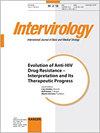Fluorescent Immunosorbent Assay for Chikungunya Virus Detection
IF 3.2
4区 医学
Q3 VIROLOGY
引用次数: 8
Abstract
Background: When infected with the chikungunya virus (CHIKV), 3% to 28% of CHIKV-infected individuals remain asymptomatic, necessitating the development of improved high-throughput screening methods to overcome the limitations of molecular diagnostics or enzyme-linked immunosorbent assays (ELISAs). Objective: In this study, two novel monoclonal antibodies (mAbs) targeting envelope 1 (E1) of CHIKV were developed and applied in a fluorescence-linked immunosorbent assay (FLISA) using coumarin-derived dendrimer as the fluorophore. Methods: The performance of the FLISA was compared with that of ELISA. Results: Using the two novel mAbs (2B5 and 2C8), FLISA could detect 1 × 105 PFU/mL of CHIKV, exhibiting a 2-fold lower limit of detection (LOD) compared to ELISA. The LOD of FICT corresponded to a comparative threshold value of 23.95 and 4 × 106 of RNA copy number/µL. In the presence of human sera and blood, virus detection by FLISA was 3-fold better than ELISA, with an LOD of 2 × 105 PFU/mL. Sera and blood interfered with the ELISA, resulting in 6 × 105 PFU/mL as the LOD. Conclusions: FLISA using two novel mAbs and coumarin-derived dendrimer is a superior diagnostic assay for detecting CHIKV in human sera and blood, compared to conventional ELISA.基孔肯雅病毒检测的荧光免疫吸附法
背景:当感染基孔肯雅病毒(CHIKV)时,3%至28%的CHIKV感染者仍然没有症状,因此需要开发改进的高通量筛查方法,以克服分子诊断或酶联免疫吸附测定(ELISA)的局限性。目的:本研究开发了两种针对CHIKV包膜1(E1)的新型单克隆抗体(mAb),并将其应用于以香豆素衍生的树枝状大分子为荧光团的荧光联免疫吸附试验(FLISA)。方法:将FLISA法与ELISA法进行性能比较。结果:使用两种新型单克隆抗体(2B5和2C8),FLISA可以检测1×105PFU/mL的CHIKV,与ELISA相比检测限(LOD)降低了2倍。FICT的LOD对应于23.95和4的比较阈值 × 106的RNA拷贝数/µL。在人血清和血液存在的情况下,FLISA对病毒的检测效果是ELISA的3倍,LOD为2×105PFU/mL。血清和血液干扰ELISA,导致LOD为6×105PFU/mL。结论:与传统ELISA相比,使用两种新的单克隆抗体和香豆素衍生的树状大分子的FLISA是检测人类血清和血液中CHIKV的一种优越的诊断方法。
本文章由计算机程序翻译,如有差异,请以英文原文为准。
求助全文
约1分钟内获得全文
求助全文
来源期刊

Intervirology
医学-病毒学
CiteScore
5.40
自引率
0.00%
发文量
13
审稿时长
6-12 weeks
期刊介绍:
''Intervirology'' covers progress in both basic and clinical virus research, and aims to provide a forum for the various disciplines within virology. Issues publishing original papers alternate with thematic issues, focusing on clearly defined topics. This thematic concentration serves to make timely reviews, research reports and controversy easily accessible to both specialists in the field and those who want to keep track of the latest developments outside their own area of interest. In addition to original papers, regular issues publish short communications and letters to the editor to provide readers with a forum for the exchange of ideas and comments. The scope encompasses work on the molecular biology of human and animal viruses, including genome organization and regulation, and the structure and function of viral proteins. The pathogenesis, immunology, diagnosis, epidemiology, prophylaxis and therapy of viral diseases are considered.
 求助内容:
求助内容: 应助结果提醒方式:
应助结果提醒方式:


